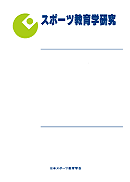
- Issue 2 Pages 1-
- Issue 1 Pages 1-
- |<
- <
- 1
- >
- >|
-
by Comparison of Sprinting Forms at Maximum Speed PhaseSaburo NISHIMURA, Akiyo MIYAZAKI, Yasuto KOBAYASHI, Yoshinori OKADE2016Volume 36Issue 2 Pages 1-14
Published: November 30, 2016
Released on J-STAGE: April 03, 2017
JOURNAL FREE ACCESSThis study aims to reveal necessary sprint techniques based on the abilities observed in male high school students. The participants were 232 boys. The experiment involved the participants performing a 50 m sprint.
Their sprinting motions were recorded approximately 35 m from the start line with a high-speed video camera using the side view angle. The participants were extracted according to their sprinting velocity by following criteria: the Excellent group (35 students, M + 1SD), Normal group (27 students, M ± 0.25SD), and Poor group (27 students, M−1SD). For evaluating the sprinting motion, joint and segment angles were obtained from the video. These were ankle joint angle, knee joint angle, shank segment angle, thigh segment angle, and body trunk segment angle. The three groups were compared through an analysis of variance to explain the significant differences between them. We identified the techniques each group needed to learn for good sprint ability based on these differences.
The results were as follows:
1) The sprint techniques that the Normal and Poor groups both needed to acquire were swinging the free leg forward with a flexed knee just after takeoff and pulling the thigh of the free leg up.
2) Specific sprint techniques that the Normal group needed to acquire were keeping the knee of the support leg less flexed during the support phase and not leaning the body trunk forward excessively at prophase in support phase.
3) Specific sprint techniques that the Poor group needed to acquire were bringing the shank perpendicular to the ground and landing forefoot.
View full abstractDownload PDF (1048K) -
Yuta ONO, Hidenori TOMOZOE, Kazuyuki NAGASHIMA, Sou NEMOTO2016Volume 36Issue 2 Pages 15-30
Published: November 30, 2016
Released on J-STAGE: April 03, 2017
JOURNAL FREE ACCESSPrevious research has shown that physical education was introduced to young men’s associations through the strong encouragement of Giichi Tanaka. However, there has not been sufficient research on how Tanaka promoted physical education to young men’s associations or specifically what kind of plans were set forth.Accordingly, this study aims to clarify in detail the concept of promotion of physical education to young men’s associations.
As a result, the following points were clarified:
1) Tanaka positioned youth education in France, Russia and Austria as single-minded military school education and while he recognized its usefulness, he perceived it as negative. Meanwhile, he perceived German youth education favorably as discipline for the body and mind as a prerequisite to activities in the military.
2) In the backdrop of German youth education as a model, Tanaka had a sense of impending crisis with respect to the current state of youth education in Japan which was in a trend of implementing excessive military style education. Based on these points, the education in Tanaka’s concept was, at least, positioned as activities in order to become healthy in terms of both stamina and spirit.
3) The promotion of physical education to the youth was, for Tanaka, keeping in mind the combination of military education and national education, an experiment that required strong and healthy spirits and bodies as a basic prerequisite for the promotion of national power and war potential at time of generalized war as well as an expansion of military training.
View full abstractDownload PDF (528K)
-
Various Approaches by Sports-Related Organizations/InstitutionsTakashi KATSUTA, Hidenori TOMOZOE, Mizuho TAKEMURA, Koh SASAKI2016Volume 36Issue 2 Pages 31-48
Published: November 30, 2016
Released on J-STAGE: April 03, 2017
JOURNAL FREE ACCESS
-
Insights Gained from Practical Competition Support for Top Japanese Junior PlayersKazuto YOSHIDA, Koshi YAMADA, Sho TAMAKI, Masaru KAGA2016Volume 36Issue 2 Pages 49-59
Published: November 30, 2016
Released on J-STAGE: April 03, 2017
JOURNAL FREE ACCESSThe purpose of this study was to clarify perspectives of teaching and evaluating table tennis services: how to display a player’s movement to his/her opponent. This study was done as a part of a 5-year period of competition support using sport sciences.
The main results and findings were as follows:
1) In table tennis service, when serving a ball far from or near to the net on the receiver’s court, there was often a difference in the first bound placement on the server’s court and the height of the ball-hitting position. Furthermore, when serving a ball to the right or left of the receiver’s court, the direction of the server’s trunk often differed between the courses. These were considered important perspectives for teaching and evaluating table tennis service of top Japanese junior players.
2) The check sheet made in this study to improve the similarity of service movement between different kinds of services was effective for top Japanese junior table tennis players, even for first-time participants. Future subjects of this check sheet would expand to include other coaches and players of varying competitive levels.
3) A comparison between the check sheet of table tennis service movement and table tennis textbooks indicated that the check sheet gave new practicable insights into coaching for improving service: how to display a player’s movement to his/her opponent.
View full abstractDownload PDF (763K)
- |<
- <
- 1
- >
- >|